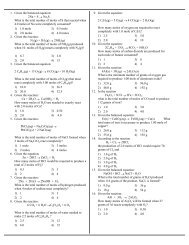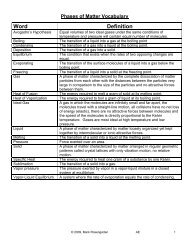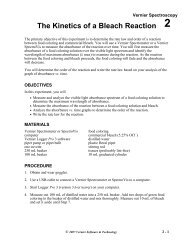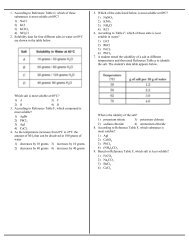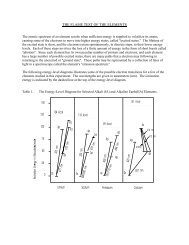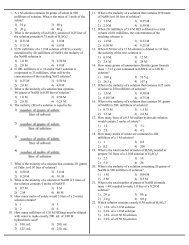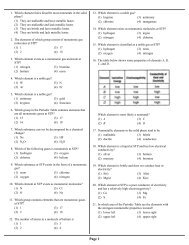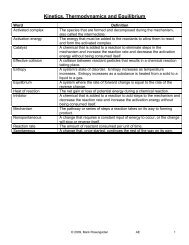Topic 1 - Matter and Energy - Revsworld
Topic 1 - Matter and Energy - Revsworld
Topic 1 - Matter and Energy - Revsworld
Create successful ePaper yourself
Turn your PDF publications into a flip-book with our unique Google optimized e-Paper software.
.<br />
<strong>Topic</strong> 3 - The Atomic Structure<br />
17. Isotope symbols: Determining <strong>and</strong> comparing particles in isotope symbols<br />
In any given isotope notation, you should be able to determine the following information.<br />
. Mass number, number of nucleons, <strong>and</strong> the sum of protons <strong>and</strong> neutrons<br />
. Atomic number, number of protons, nuclear charge, <strong>and</strong> number of electrons<br />
. Number of neutrons<br />
When two isotope symbols are given, you can determine <strong>and</strong> compare the number of particles between<br />
them.<br />
Below, an isotope of sulfur <strong>and</strong> an isotope of phosphorous are given.<br />
As you study the information below:<br />
Note the differences <strong>and</strong> similarities in the number of particles between the two isotopes.<br />
Number of Protons + neutron<br />
Number of Nucleons<br />
34 Mass number 33<br />
S<br />
16 Atomic number 15<br />
Number of protons<br />
Nuclear charge<br />
Number of electrons (if neutral)<br />
_________________________________________<br />
18 Neutrons (top # - bottom #) 18<br />
P<br />
According to information from the isotope<br />
symbols, the following comparisons can be<br />
made:<br />
34 S has more nucleons than 33 P<br />
33 P has one fewer proton than 34 16 15 S<br />
34 S has a greater nuclear charge than 33 P<br />
P-33 has the same number of neutrons<br />
as S-34<br />
as<br />
18.Isotope symbols: Determining <strong>and</strong> comparison number of particles in isotope symbols<br />
Concept Tasks: Be able to determine the number of subatomic particles from a given isotope notation.<br />
Be able to compare the number of subatomic particles of two given isotope symbols.<br />
Example 10<br />
To correctly determine <strong>and</strong> compare number of particles in isotope symbols, you<br />
must know where to look isotope symbols. (see above notes)<br />
The use of your Periodic Table is also recommended.<br />
What is the total number of protons <strong>and</strong> neutrons<br />
in the nuclide 80 Br<br />
1) 35 2) 80 3) 45 4) 115<br />
Answer: Choice 2. Top number (80) is the mass number.<br />
Mass number = Protons + neutrons<br />
Example 11<br />
35<br />
The nucleus of the atom<br />
1 07<br />
Ag contains<br />
1) 60 neutrons <strong>and</strong> has a nuclear charge of +47<br />
2) 60 electrons <strong>and</strong> has a nuclear charge of +47<br />
3) 47 neutrons <strong>and</strong> has a nuclear charge of +107<br />
4) 47 electrons <strong>and</strong> has a nuclear charge of +107<br />
Example 12<br />
Which nuclide contains the greatest number of<br />
neutrons?<br />
1) 207 Pb 2) 84 Kr 3) 207 Ti 4) 208 Bi<br />
Before choosing:<br />
Determine atomic number (bottom #) for each.<br />
Subtract bottom from top to get # of neutrons<br />
207 Pb<br />
84 Kr<br />
207 Ti<br />
208 82 36 81 83Bi<br />
Neutrons = 125 48 126 125<br />
Answer: Choice 3.<br />
Example 13<br />
Which nuclide contains 20 protons?<br />
1) Ca-40 3) B -10<br />
2) Ne-20 4) He-5<br />
Answer: Choice 1. Ca has an atomic<br />
number of 20<br />
20 protons = atomic number 20<br />
Answer: Choice 1. Ag has atomic number of 47.<br />
+47 Nuclear charge = atomic number 47<br />
60 neutrons = 107 – 47<br />
Copyright © 2011 E3 Scholastic Publishing. All Rights Reserved. 57





